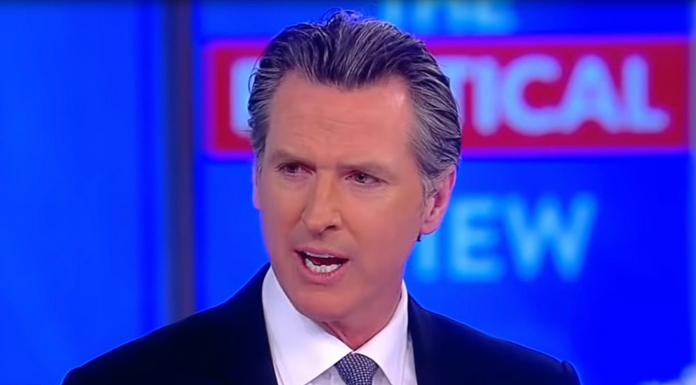California is the world’s fifth-largest economy — larger than India — and it can’t keep the lights on.
All it took for the spectacularly mismanaged state to fall victim to its own “green” energy policies was a summer heatwave. Thanks to a religious aversion to fossil fuels, hundreds of thousands of homes and millions of Californians lost power for two days last weekend as the ever-increasing shift to renewable energy failed to deliver electricity when state residents needed it most.
The California Independent System Operator (CAISO), which runs the electrical grid, has already warned of another electricity supply shortage.
The crisis has been compounded by the state’s Wuhan virus pandemic lockdowns and stay-at-home guidelines that have put the elderly, disabled, sick and other vulnerable populations at extreme risk without air conditioning and basic electric services.
The root cause isn’t climate change, as green energy proponents zealously contend. Rather, the state’s electrical grid has significantly transitioned away from oil and natural gas to solar and wind energy production to keep up with the Democrat-controlled state government’s goal of 60 percent renewable energy by 2030.
California is nowhere near that goal and the plan has already proved to be a disaster — not unlike the state’s $100 billion green bullet train to nowhere.
Facing public outrage, and a pre-existing recall effort, Gov. Gavin Newsom, a Democrat, signed an emergency proclamation allowing some energy users and utilities to tap backup energy sources amid statewide rolling blackouts.
He then demanded an investigation to find the culprits responsible for what he carefully called “de-energizations,” though the cause was widely known to be system-overwhelm.
In a letter to the CAISO, which Newsom controls, he insinuated that unpopular state utility companies were at fault for not providing sufficient warning, though he failed to mention that the utilities were in full compliance with state regulations.
“I write today to express my deep concern about the broadscale de-energizations experienced by too many Californians on August 14 and 15th. These blackouts, which occurred without prior warning or enough time for preparation, are unacceptable and unbefitting of the nation’s largest and most innovative state,” Newsom wrote.
State policymakers and utility officials knew the blackouts were coming. On the merits, California’s green energy politics don’t allow for realistic solutions.
On Friday evening, prior to the electricity collapse, CAISO asked all energy consumers to voluntarily reduce their electricity use.
The request came amid longstanding statewide recommendations that include raising thermostats during the hottest hours of the day and refraining from using household appliances from 3 pm to 10 pm.
But it didn’t work and a “Stage 3 emergency” was declared, followed by power cuts across the state of 40 million people at 6:30 pm — or around sunset.
It was actually the second time rolling blackouts occurred within the past year. In October, Pacific Gas and Electric cut power to hundreds of thousands of homes to avoid contributing to record forest fires. That crisis was fueled by unprecedented amounts of forest debris resulting from anti-logging and anti-development environmental policies — though it was blamed on climate change.
Newsom similarly fingered PG&E as the blackout culprit and attacked the heavily regulated utility for “greed and mismanagement.” He then named a top aide to be his “energy czar.”
“This is not the new normal, and this does not take 10 years to solve,” Newsom said. “The entire system needs to be reimagined.”
But the system is reimagined, and its proponents want it replicated throughout the United States.
The shift to solar energy requires a decreasing involvement of natural gas, a cheap, reliable source of energy that’s naturally abundant in California.
The problem with solar energy is that it can’t compete with natural gas and fossil fuels on a unit-to-unit basis. Solar power also evaporates when it’s not sunny, which was the issue last weekend. The state’s electric grid teetered on supplying energy for air conditioning and other mundane purposes during the day, and the grid collapsed in the evening hours and night when it was no longer sunny outside.
“The peak demand was steady in late hours,” said a CAISO spokesperson, adding, “and we had thousands of megawatts of solar reducing their output as the sun set.”
Cloudy days and winter months when home heating demands will assuredly escalate are other challenges that solar energy policymakers have yet to resolve.
Wind energy has also proved a total failure. Wind has been virtually nonexistent during the summer heatwave which has further burdened the grid. The same weather pattern that’s caused elevated temperatures, a stable high-pressure bubble, involves little to no wind and the resulting effect is climbing temperatures.
The great irony is that California is awash in natural gas, which climate change activists embraced only a few years ago since it burns much cleaner than other cost-effective and reliable fossil fuels, like oil and coal.
But the tens of billions of dollars in state revenue that has been diverted to solar and wind has not only jeopardized that state’s energy system, it’s made it the most expensive in the country.
California electricity costs more than twice the national median, and state government policies are intentionally driving more competitive energy sources out of business.
Natural gas and nuclear power plants that can generate cheap power around-the-clock have shut down in recent years because they can no longer compete with heavily subsidized green energy initiatives.
“A 10-year-old natural gas power plant in California’s Inland Empire is being decommissioned this year — 20 to 30 years earlier than its planned lifespan,” the Wall Street Journal editorial board recently reported.
“The Sacramento Democrats want to take this policy nationwide via Joe Biden, so prepare for hot summer nights,” the board concluded.
Biden’s running mate, Sen. Kamala Harris, a California Democrat, could bring that prediction to fruition if the addled Biden is elected, especially if he resigns due to health reasons.

